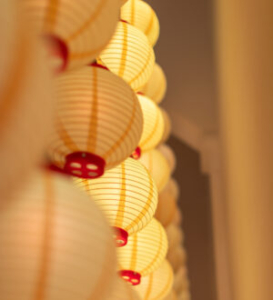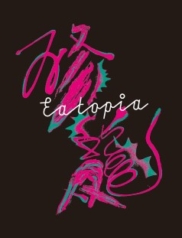Light Up
By Jo Phillips
Enter the space, the room is dark, except for a lit-up table where sits 7 metronomes. Choose one and set it in motion, it will start to swing within its own ‘beat’, after around 15 seconds it starts to sync in time with the other six metronomes on the table. A short video starts at the same time, creating an immersive experience . Welcome to the Taiwanese room at the London Design Biennale, you have just entered Swingphony.. Find out more in Light Up Here.
The Taiwan Pavilion team uses Swingphony as the main concept behind its interpretation of the London Design Biennale’s theme – Resonance. The inspiration comes from the diversity of religions in Taiwan, combined with physics, namely, The Schumann Resonances.

The Schumann resonances are a set of spectrum peaks in the extremely low-frequency portion of the Earth’s electromagnetic field spectrum; global electromagnetic resonances, generated and excited by lightning discharges in the cavity formed by the Earth’s surface and the ionosphere. It is often referred to as “the heartbeat of the Earth”
Taiwan is highly diversified in terms of religious belief, with the practices of Buddhism, Taoism, Christianity, Mormonism, Yiguandao, the Unification Church, Catholicism, Islam, Eastern Orthodoxy, Judaism, and Hinduism, as well as native sects such as Yiguandao utilized. A country that respects traditional faiths all the way to other types of religious thinking. The common them of praying, chanting and meditation in each and every practice.
Therefore the metronomes represent the ideas of chanting, praying and meditation as a form of prayer offered up the heavens because communal chanting, praying and meditation all of which are proven to increase Alpha Waves. Alongside think about the ideas of incense often seen in many east and west Asian practices that consider it a path for the prayers to easily reach heaven.
These Alpha waves are the brain waves most commonly associated with reducing stress, The Alpha Wave’s frequency is between 8 and 12 Hz, almost the same as The Schumann Resonances. The aim of Swingphony is to enable visitors to understand the Alpha Wave, harness natural electromagnetic resonances and experience communal sound rhythms, to highlight the power of unity in a fragmented world.

As the seven metronomes begin to ‘beat as one’ the paper lanterns in the room light up the darkened space. The lanterns symbolise Taiwanese temples as no matter what the religious practice lanterns are commonplace in any temple. also in Taiwan, it is common to walk into any temple space whether it be in a shopping centre or on the side of a street and pray any religion you choose. The temples are not religious specific.
The exhibition has 3 features key items as explained by the team behind it: ‘lanterns represent hope, metronomes make the hope hearable, visual art makes the hope visible. The pendulum was inspired by the “incense” in the temple, supplemented by red LED lights at the top, representing the image of incense. Incense represents the connection between man and heaven. The swinging red light symbolizes our hope for the future. The shape of the metronome is inspired by the image of folded hands. Individual actions cause resonance to other groups. Everyone connects with other people and all things in nature invisibly, especially in the epidemic, the whole needs to be united’.
The creator of Swingphony, is Bito an international award-winning design agency, and Swingphony is led by Bito’s Creative Director, Keng-Ming Liu. He formed an interdisciplinary team of film directors, graphic designers, digital artists, illustrators, animators and copywriters, in order to fulfil the Taiwan Pavilion’s mission to bring a unique and positive interpretation of this years theme, Resonance.
.Cent was able to ask the following question to Keng-Ming Liu:-
How did the idea of exploring religion come to you for this installation?
“Religion has always been a part of my life and for most Taiwanese people. We pray for everything from school exams to job interviews and their love life. Recently with the COVID-19 pandemic, we’re all praying for our family and friends’ health. I think we all need something to bring us together right now, and that’s how I came up with Swingphony”.
He also went on to say :-
“The message is for everyone, including atheists and agnostics. The main religions in Taiwan are Taoism and Buddhism, which are quite different to Christianity and Islam, as we don’t have daily or weekly gatherings for prayer – instead we follow our own schedules. To us, the most important thing in religion is the ritual repetition of prayer, which brings harmony to our lives. The idea of Swingphony applies to not just religion, but also everything in our daily life, and the purpose is to achieve harmony via resonance”.
A simple concept of oneness: No matter what path you may take to whatever you consider the greater power ‘above’ the Pavillion Swingphony is almost like a conduit to a high level of spirituality and consciousness. like many world religions and as the kabbalists also explain we are more powerful when we come together as one. This is why, in so many religions, we are encouraged to pray together. The more of us the more powerful the prays. As here, the more in sync the metronomes the lighter the room gets.
Established in 2016, The London Design Biennale promotes international collaboration and the global role of design. The third edition of The London Design Biennale is taking place from 1st June to 27th June 2021. Participants respond to the exhibition’s theme: ‘Resonance’, which considers the ripple effect of ground-breaking design concepts on the way we live and the choices we make.

Sponsored by the Ministry of Culture, Taiwan, organised by the Taiwan Design Research Institute (TDRI) and curated by Bito, the Taiwan Pavilion presents its Swingphony exhibition at this year’s London Design Biennale. The Taiwan Design Research Institute (TDRI), the organiser behind the Taiwan Pavilion, is a cross-boundary, integrative design platform for value creation services.
For more information on the piece please click Here
Mon-Sun 11.00-19.15
The London Design Biennale Taiwan Pavilion Somerset House Strand London WC2R 1LA United Kingdom
If you enjoyed Light up then why not read Plant-Based Art Here.





